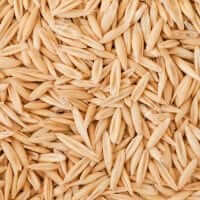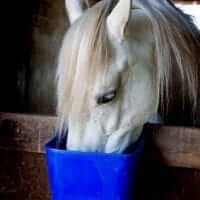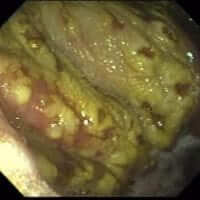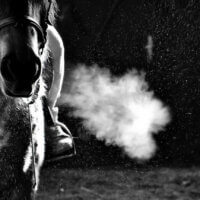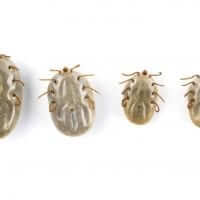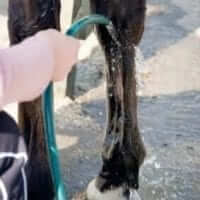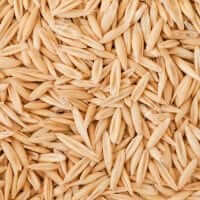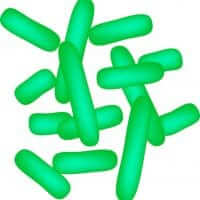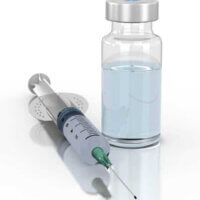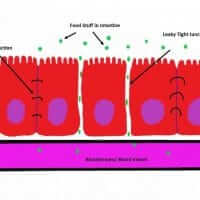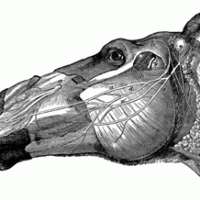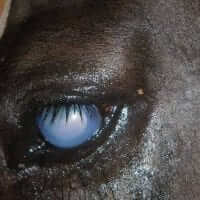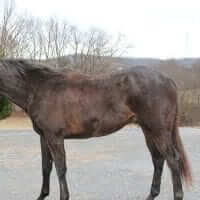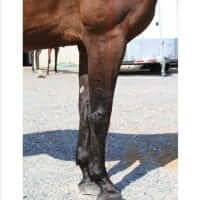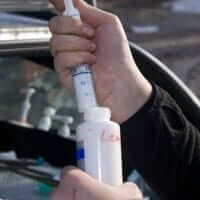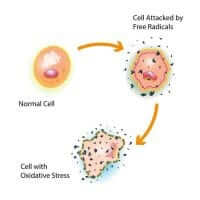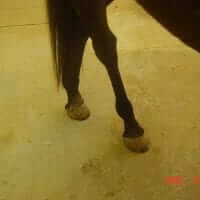Equine Articles
One of my major concerns, as a veterinarian and researcher, is the inflammatory process and how it can dictate health and soundness. This process is complex, involving many contributors, but diet is a major player. As we investigate further the impact of gastrointestinal health on overall health and soundness, certain things begin to fall into place and become more obvious. The first item is diet, what we are feeding and how we define this. The second item of concern is the picky eater, which more than likely we have all encountered at one time or another. Many owners feel this ‘pickiness’ is often ‘cute’ or a trait for a particular horse….but is there more to it? Is this actually a symptom or sign of something larger?
Read MoreStomach ulcers in horses are quite common, actually becoming more of a problem that in the past for our equine patients. It has been estimated that upwards of 80% of all horses, including sedentary and those in training, exhibit gastric ulcers but not all are clinically evident. In some studies, it has been demonstrated that just by moving a horse into a barn or training facility, the incidence of stomach ulcers increases beyond 80% and upwards to almost 100%. Some cases of ulcers are obvious with typical clinical signs, while others are more ‘quiet’ in nature and often only diagnosed incidentally. The sad part is that for many of these horses, they live a life on constant medications to control the clinical symptoms, which not only is not solving the problem but also costing the owner money and even, based on some studies, potentially inflicting harm. We need to dig deeper to find better ways of managing this problem.
Read MoreOne of the most common equine health conditions impacting the performance horse involves the respiratory tract. Inhalation of oxygen is vital for energy production and overall cellular health, but in manty equine athletes, they struggle to move air in and out, resulting in decreased performance and quality of life. As horse owners, we rely on pharmaceutical medications such as steroids and bronchodilators, but despite their use, we continue to struggle to gain results and improve life for our equine companions.
Read MoreStocking up is a familiar term to many horse owners and often is used to refer to a horse that exhibits leg swelling. The exact cause of the swelling can be variable and with this, so can the prescribed treatment course. The more we understand, often the better we can assist these patients, but it is a complicated problem in the equine industry.
Read MoreHappiness and an end to suffering. That is the goal for almost all of mankind. We want it, crave it and desire it on many levels. Disease occurs on many levels and impacts all of us either directly or indirectly. The perception of that disease, whether if it affects us our pets or our horses, can vary from person to person. One may say it is acquired or there is a genetic predisposition to that condition. On the other side of the coin, another person may say the disease is a reflection of our environment, diet and other factors…essentially implying we created it. It is all relative, in my opinion, but one thing is for certain and that is that with a complete understanding of what is occurring, we stand a better chance of prevention as well as management.
Read MoreWhen we think of fats in the horse’s diet, the first few things that come to mind are to improve the shine in a hair coat or to put weight on a horse in need. Although these are both true, there is much more to fats that what meets the eye and thus, a better understanding is needed. Fats are valuable sources of energy and calories, but there are potentials downfalls as they impact health on many levels, and not every horse is in need.
Read MoreHow to feed a horse is one of the most popular questions that I get as a veterinarian. There are many things to consider, mainly being macro and micro nutrient provisions, which include proteins, fats, vitamins and minerals. Protein is essential for the body in a variety of ways, from building muscle mass to regulation of metabolic function. How much protein is needed is dependent on each horse and the demands present. Exact recommendations are hard to make, generally speaking, but in most cases, we have to look at each individual horse, demands, existing health problems and dietary sources.
Read MoreProbiotics are common in today’s equine industry and even human health. They are heavily marketed for supporting gastrointestinal health on many levels, but are they really needed and are they really beneficial? There are many types of probiotics promoted in various products, but unfortunately, they are all lumped together and promoted as being beneficial, which can further muddy the waters. So how do we know if we need to use them and if so, what types are most beneficial? The answer to this question lies not only within research but also through clinical experience.
Read MoreSupplementation: What is the Goal and How to Achieve it.
The term ‘supplement’ can either be a noun or a verb, implying something that completes or ehances something else, or in the case of a verb context, to add an extra element. In the health industry, we really use the term in both contexts or sometimes both at the same time. We may supplement our horse’s or even our own diet with a supplement, using both the noun and verb, which is commonplace. However, what are we really doing and what are we trying to achieve? Through a better understanding, we may be able to arrive at that goal a little sooner and even reduce end costs in the long term.
Read MoreRespiratory conditions in the horse are very common, but present in many forms. As horse owners, you may be familiar with terms including allergies, inflammatory airway disease (IAD) and chronic obstructive pulmonary disease (COPD). These terms get tossed around quite often and in many cases, despite the final diagnosis, we fail to see the connection between all of them and the possibility that one can progress to another over time.
Read MoreJoint disease is a common manifestation of life, aging and often a result of many contributing factors including conformation, deformities and repetitive overuse. In horses, joint pain is common not only with aging due to deterioration, but is also present in the younger group secondary to high levels of stress to the areas associated with training and competition. In all groups, we have an often daily dependence on pain medications, but in horses, this progresses one step further to include repetitive joint injections to help keep the athlete competing. In many respects, we have come to accept these therapies as the only means of management, but are they really helping and is there more that can be done? Is it also possible that some of these therapies, despite good intentions, may be creating more harm in the end? With further knowledge, we can understand better and consider different options.
Read MoreSpring is upon us and with the increase in pollen and other allergens, those horses with prior respiratory allergies can flare, creating a life of misery for them and their owners. Respiratory conditions impact a large percentage of horses, contributing to health problems ranging from poor performance to complete debilitation. Chronic obstructive pulmonary disease is one of the most common respiratory conditions affecting the horse, which can be frustrating to manage. Just like other health conditions, the more we know and the earlier we intervene, often the prognosis is improved and management made easier.
Read MoreHeadshaking in the horse is a common problem and often affecting up to 30% of patients to variable levels, creating high frustration for the horse owner. The exact cause of this condition can be variable from patient to patient and thus treatment and results can be variable. Headshaking can vary in regards to presentation from simple flaring of the nostrils, flipping of the nose, rubbing the nose, snorting often, sneezing and even variable degrees of overt head shaking. Given the wide range of presentation,potential causes, lack of consistent treatment response and frustration factor for the horse owner, headshaking deserves some investigation for better management options. As is my character, let’s dig into what we know regarding headshaking and see if we can not only make sense of it, but also discover potentials for therapy.
Read MoreLameness in the horse can come in all different forms and severities. One common source of lameness is the stifle but in many of these cases, it is also common to have problems either higher up or lower in the limb often tied in with conformational flaws or even trauma. The saccroiliac region in the lower back or hip region is also a common source of discomfort, either alone or in conjunction with other problems. The saccroiliac (S/I) joint is the area where the pelvic bone called the Ileum joins up to the Saccrum of the lower back. The junction of the two is actually termed a joint, being held together by tough fibrous tissue, but still demonstrates some movement as the horse travels. In a recent case presented for rehabilitation, we actually had apparent S/I problems in addition to chronic stifle lameness. When combined with unhealthy feet, severe thrush and sole pain, the case proved to be a real challenge.
Read MoreOne of the most common problems in the equine athlete and pleasure horse is recurring lameness, which can be equally frustrating for owner, rider and veterinarian. At one moment, the issue may seem resolved, bringing relief, but then it may recur or maybe even a new problem develops. Being a veterinarian, horse owner and involved in the rehabiliation of horses, I understand the frustration but have come to realize that there is much to discover, learn and reveal when it comes to seeing the ‘entire’ horse in these situations. More often than not, the primary problem the horse is presented for is actually not the main issue, but in order to see the true problem, we need to step back and look at several factors. Despite us wanting to fix everything in one fail swoop, often the issue is more complex than we would like it to be.
Read MoreWhen we think of inflammation, it is often in the form of pain and swelling. Joint pain, stiffness, a wound or cut, sore back, sore throat or even an ear infection. All of this is true and these conditions are associated with inflammation, but the overall concept goes much deeper, often being unrecognized clinically but all too closely tied with other health conditions. It is an important concept to grasp, even on the most basic level, as with this understanding, we have opportunities to intervene which may give us more opportunities to manage and even prevent certain conditions.
Read MoreDisease Prevention & Management; The 20,000 Mile View
Everyone is looking for the ultimate cure or answer to whatever condition impacts their health or lifestyle, whether if that is for themselves, their pets or their horses. Is there an answer out there? A solution to what ails you? The answer is more complex than what you would like to hear, not necessarily a ‘yes’ or ‘no’, but more or less in between.
Read MoreDoes your horse have a healthy and strong immune system? How do you know? The most common problems we associate with a poorly functioning immune system are recurrent infections and even allergies, but what about other conditions? Even in the case of infections, we most often attribute a poor immune response to more severe infections that may even result in hospitalization, but are there other clues or more subtle situations that may indicate that we have a problem? The immune system is complex and involved in more bodily processes than one might just realize.
Read MoreNutrition Implications: Fact or Myth
As a veterinarian, I have to confess that after almost 20 years of clinical practice, I failed many of my patients due to lack of knowledge about proper nutrition. Being a student in veterinary school, honestly, there was not much focus on nutrition. In some courses, there was mention of various nutrients, but not much pressure to use the diet as a tool to aid in disease management and recovery. The good news is that after all of those years, I did ‘wake up’ and realize the importance and today, my approaches are much different for myself, our pets and those horses that I have contact with on a daily basis. It wasn’t always this way and I discover more each day, which can be exciting!
Read MoreDo you have a horse or know of one impacted by EPM? Equine Protozoal Myeloencephalitis (EPM) is unfortunately a common disease in the horse, impacting hundreds, if not thousands every year. The outcomes for each case can vary dramatically, resulting in a huge expenditure for the owner and an uncertain future for the horse. Give the huge variability in outcomes despite newer treatment options, one is left asking ‘why’ and what more can be done to aid in prevention and therapy to help increase the success rates. Maybe it is time to rethink our approach to these cases in order to maximize the outcome.
Read MoreWhich Cur-OST formula is right for my horse?
Our Cur-OST® formulas target a healthy inflammation response and were created originally to benefit Dr. Schell’s equine patients, helping to improve overall health, joint mobility, performance and reduce aches & pains. There are many joint and health supplements available for horses, but the goal with our formulas is to first provide natural ingredients and herbs that are effective in their actions and second, provide the highest levels based on research to get those results. The choices between the Cur-OST® equine formulas may appear confusing but really, there is a strategy for each formula. The most common question we have is ‘which formula is right for my horse?’. The answer is not straight forward considering that each horse is an individual, but hopefully we can outline the goals and uses for each formula.
Read MoreDaily aches and pains are one of the biggest problems we deal with as we get older, but they are also very common in our pets and horses, especially if they are athletes. The aches and pains are often associated with joint deterioration on many levels with resulting cartilage degeneration, which creates discomfort. Most people resort to traditional joint therapies, including glucosamine and chondroitin, in addition to various pain medications such as non-steroidal anti-inflammatories to help control pain. Despite these efforts, many are still seeking options to help get to the next level of comfort not only for themselves, but also for their equine companions and pets. Let’s take a look at what is going on and what other options may be available.
Read More

